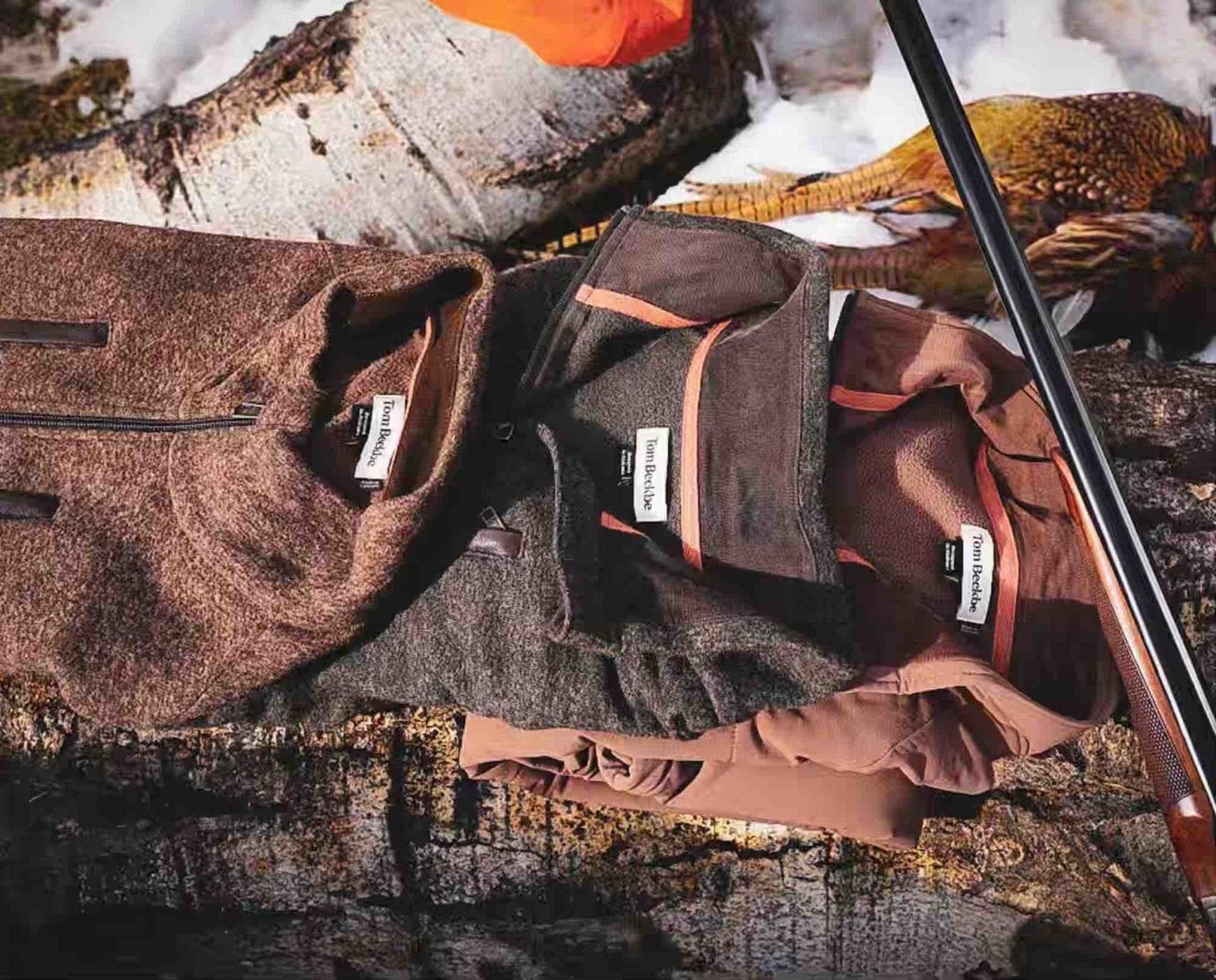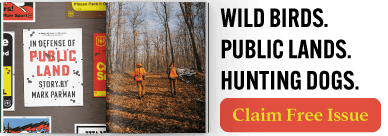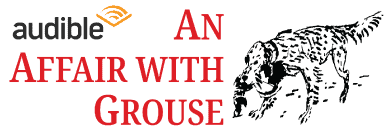Home » Hunting Gear » Tom Beckbe Performance and Knit Fleece – A Long-Term Review
Tom Beckbe Performance and Knit Fleece – A Long-Term Review

Michael R Thompson is an independent artist and custom knife…
Reviewing technical upland clothing with a traditional aesthetic
Upland hunting often has a distinctive aesthetic that follows a rich tradition of hunters going afield in search of birds. You see it in paintings old and new. You see it in magazines published fifty years ago and blogs published last week. It is as easy for us to identify with as it is for us to be identified by it.
The scene looks something like this: two bird dogs working an area (maybe flushers, maybe pointers), both displaying body language to give away the presence of quarry; two hunters, guns held at the ready, wearing earth-toned briar pants made of coarse material to help turn the thorny brush that makes up the bulk of this landscape. The hunters are wearing contrasting earth-toned vests with a splash of dirty orange; the vests are designed to carry red plastic shells with brass bases and then birds if those shells find their purpose. Maybe one of the hunters wears a wide-brimmed hat, battered well beyond public display for everyday life but just about perfect to take into the field. The other hunter wears a baseball cap—pure upland Americana.
As the hunters move toward the dogs, a covey of birds erupts from all around them. Maybe it’s the screen-door-slam of a Hun flush or the static-electricity-hum of bobwhites. Perhaps it’s the thunder of a pair of grouse or possibly just a lone pheasant cackling in defiance. This is what many of us think of when we think upland. This is one of the reasons why the upland community is so tight-knit and appreciative of tradition, regardless of our differences. When it comes to our clothing, tradition plays a large part in the aesthetic; it’s almost as if we have a uniform that instantly identifies us to others that might recognize us.
Traditional aesthetic versus technical upland clothing
Perhaps that reverence for a traditional aesthetic is why we have been so slow to embrace technical clothing. Sure, many of us in the West who hike or hunt big game have adopted pieces of technical gear into our upland wardrobe because we know how effective it is at keeping you comfortable and—in some cases—keeping you alive. I, however, don’t see any upland-centric brands offering a system of clothing catering to the bird hunter, which has always puzzled me. The closest thing to a “system” I can think of are those bird hunting jackets with zip-off sleeves and removable liners to suit the changing conditions. I always felt those were a nice try but they never performed well enough to justify carrying into the field. So why is there nothing upland-specific in technical clothing?
A quick google search gave me the answer I was looking for:
“A technical textile is a textile product manufactured for non-aesthetic purposes, where function is the primary criterion.”
This is true of many technical pieces of hunting clothing: by and large, they look like pajamas or long underwear. Sometimes they may come in camo (to which many uplanders are allergic) which makes them visually easier to stomach, but they just don’t have the looks that make you think of upland tradition. Worse still, you might be misidentified as a duck hunter! Adding insult to injury, you don’t need to be a super athlete to be a successful uplander, but many of these technical brands make “athletic fit” pieces that are designed to hug the body tightly like a sausage casing and don’t come in inclusive sizes.
Technical clothing holds function over appearance, often made from synthetic materials that block wind or help wick away moisture. Natural materials are typically only wool, usually Merino, which, unlike cotton, will keep you warm even when soaked. Pairing some of these offers maximum efficiency. Brands that offer pieces of technical gear have yet (to my knowledge) to create an upland-specific system of pieces to work alone or together to maximize the potential of those garments…until now.
Tom Beckbe technical upland clothing
Enter Tom Beckbe, a small American company with a good eye for that upland aesthetic as well as the hunting tradition. They are well-known for their incomparable waxed cotton Tensaw jackets lined with fabric stained red to emulate Alabama clay, as well as other waxed cotton or leather goods steeped in upland tradition. That is why their new fleece line-up was such a surprise to me.
What I initially thought to be just another good-looking set of earth-toned fleece tops with leather trim—appropriate for the field, the lodge, or doing winter chores in the offseason—turned out to be one of my all-time favorite upland pieces of clothing. It is the first bird-hunting-specific clothing systems that isn’t technically a “system” at all. Radcliff Menge, the founder of Tom Beckbe (Tom Beckbe is a play on words from the French pronunciation of the Tom Bigbee river) was modest when I asked about these pieces. He claims they aren’t a system, even though they are designed to work together and benefit from each other—I’m calling that a system.
Tom Beckbe performance fleece quarter zip
The backbone of the “system” is their performance fleece quarter zip. It’s made with Tom Beckbe’s Storm Fleece which is highly wind- and water-resistant from a DWR coating. It is also very breathable. It reminds me of a lightweight softshell without the bulk and lack of breathability that softshell jackets are normally associated with. Coupled with a lightweight merino base layer, this can take the active hunter comfortably into some pretty harsh conditions. I tested this piece alongside a very well-known competitor’s softshell on a day that started out in the teens with a steady wind. The Tom Beckbe Performance Fleece blocked the wind better than its competitor, held warmth better, and breathed better. It was also noticeably lighter. Would I survive a night out in cold weather like this with only this jacket to keep me warm? I doubt it, but this Storm Fleece jacket was not meant to be worn in such extreme conditions. I wanted to see what it could do against one of its competitors leading the industry in technical clothing systems and it impressed me on several levels.
Tom Beckbe knit fleece quarter zip
The next piece in the Tom Beckbe line up is the knit fleece quarter zip made from the same material as the knit fleece vest. This top can do a lot of heavy lifting when it comes to your outdoor wardrobe. Paired with a lightweight merino base layer, it’s perfectly comfortable to wear during activity from 30-50 degrees. If you get too warm and start to sweat, it wicks efficiently. If you are more susceptible to the cold or prefer to be stationary in a duck blind, wear the knit fleece underneath the performance fleece to stay toasty warm.
If you are climbing chukar hills in January after a long season of ruffs or roosters on flat ground, you are going to sweat profusely. In that case, wear the performance fleece underneath the knit fleece and stay dry because the knit fleece will pull the moisture away from your body and the performance fleece while your body heat and the wind will help it evaporate.
Real-World experience with the Beckbe technical clothing
Since I moved to Montana in early November I have practically lived in all three of these pieces, from shoveling snow to shopping, in addition to bird hunting. I found this system to be incredibly versatile. On a recent late-November sharptail hunt near Montana’s highline, the morning started at 17 degrees Fahrenheit without taking into account the windchill from the steady wind. I wore the performance fleece quarter zip top and the knit fleece vest with a merino base layer underneath and was perfectly comfortable while on the move. Many pieces of clothing labeled as “windproof” are not the most breathable, so my hours of post-holing through crusty snowdrifts could have worked up a dangerous sweat. However, the benefit to having a warming layer on top of a breathable windproof layer is that it lets you dry out from perspiration or an accidental soaking quicker than if you were just wearing cotton.
On the other side of extremes, we had a freak heat wave last December that brought the temps in eastern Montana up to the high 50s and even 60s in some areas. While it was unseasonably warm during the day, the early mornings were still frigid. It was wonderful to start the day wearing the quarter zip knit fleece vest and long sleeve knit fleece top. As things warmed up, I stowed the long sleeve and just wore the knit fleece vest while bagging my limit of roosters.
Versatility for more than just hunting
These pieces are comfortable together or apart in the field, yet I can also wear them just about anywhere out of the field without broadcasting to the entire world that I am a hunter. I am not one to sticker-blast my truck with logos that might give away my purpose when I am parked on some back road. I want other bird hunters to think my vanilla truck might belong to a hiker or yet another deer hunter. When asking for permission to hunt on private land, I hate wearing blaze orange and other clothing that shouts, “Hunter!” I feel like it brings a sense of urgency with it and maybe unwanted pressure to the person you are cold calling. I feel it’s best, if at all possible, to dress respectably and show the landowner you aren’t some scrub that wants to run willy nilly all over their land with a gun and questionable dogs. As functional as they are, these pieces also look classy enough to wear them while shopping or even to a concert when the world reopens without looking out of place one bit.
Perhaps an upland clothing system is not something you’ve considered. Maybe your hunts are too short to warrant it, but for folks that enjoy spending half or all day out in the field, a lightweight system like Tom Beckbe’s will only improve your time outside by allowing a level of comfort that is just not possible with cotton or nylon pieces. They will allow you to stay out and not only endure the elements, but enjoy them as well.
This was not a paid review.
Michael R Thompson is an independent artist and custom knife maker living in the Bitterroot valley of Montana with his setters and labs.



